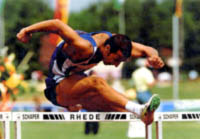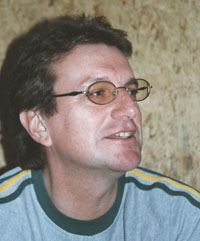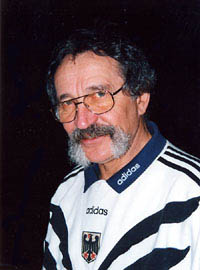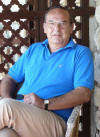|
|
What about ... ? |
|||||||||||||||||||||||||||||||||||||
|
Warum Sya-flex? Erfahrungsberichte Meinungen FAQ´s Sicherheitshinweise Info und Lieferung Preise Bestellen Referenzen Curriculum vitae
AGB
Optimised for |
Attack hurdles without fear or scruple by
Flexible Hurdle Slats for Track and Field Training Hurdle
Simple in handling Effective result I: Reason and objective of the invention sya-flex® The conventional training hurdles and the competition hurdles, produced by the majority of the sport device manufacturers, available on the market would not fulfil the requirements and/or conditions, which I needed as a coach for my exercises. From my point of view neither the training nor the competition hurdles allowed to learn correctly the specific movement pattern of the lead leg, i.e. active attacking and lead-leg snap down after the hurdle. Thus I thought over a new implement, which would correspond on the one hand to these requirements and on the other hand be easy to use. It was clear the only solution had to be a flexible, hurdle slat swivelling in all directions. After the initial attempts with the prototypes of my invention, in practice with pupils and young people, the equipment developed undreamed of possibilities regarding its application, so I thought of making it available to the public.
II. Putting the idea into action 1. Flexible hurdle slat construction - world première In standard definition competition hurdles are obstacles that the sprinter has to surpass as fast as possible. These (competition) hurdles are made of a metal stands together with a wooden hurdle board (slot, bar) placed as a barrier. These hurdles are manufactured such as to require a force of minimum 3.6 kilogram (regulatory rocking strength) against the upper centre of the board (cross-bar) in order to knock over the hurdle. Counterweights can be adjusted so as to account for various heights of the board, which is attached firmly to the metal stand. The hurdle slat is firmly embodied and thus rigid and unyielding at the ends.
In order to eliminate this "deficiency", i.e. the rigid and unyielding construction, regarding training methodology, sya-flex® the flexible hurdle slat consists of four parts. To guarantee its flexibility the sya flex® hurdle slat consists of a steel-spring, two connecting pieces, a plastic tube (so-called half hurdle slat) and an attachment, which serves the simple and fast assembly to any competition hurdle. Due to the spring and the connecting pieces the sya-flex® hurdle slat gives way in each direction even when only a small amount of force is applied. The sya-flex® hurdle slat swivels briefly and then returns rapidly again to the resting position. Thus I had solved the problem of the unyielding slat.
2. Simple assembly and handling The second challenge to my invention was to create simple handling and a fast assembly. A substantial role played for me that the new implement could be adapted to existing equipment, i.e. competition hurdles; but these could be easily reconverted to their original function. So I wanted to avoid that the clubs, schools, etc would have to buy an additional set of new training hurdles, which could only be used for training purposes, particularly because storage is usually very limited. So I managed “to kill two birds with one stone” by mounting the sya-flex® hurdle slat on the existing competition hurdle after removing the competition cross bar and I could still use the already existing counterweights. As commonly known, the practice hurdles do not have counterweights. By using the sya-flex® hurdle slat, the counterweights are essential. Thus the assembly of the sya-flex® consists of removing the existing hurdle slat and inserting the sya-flex® into the left or right opening slot of the hurdle stands. Sya-flex® is perfectly made to suit most competition hurdles, so that it can be fitted without even needing to be screwed in. The change of the hurdle slats (cross bars) requires per hurdle approx. three to five minutes. Since I assume each association has a set of competition hurdles, it would not be necessary each weekend to reconvert the hurdles for competition purposes.
III. Application possibilities Due to its 360° flexibility and the possibility of adjusting the half hurdle slat to different heights arise numerous application possibilities. In addition, the invention improves the quality of the hurdle clearance, as well as the special training of the lead leg and/or trail leg. Used in other training sessions (see also empiric report) you can improve the quality of jump training by optimizing the motion patterns during the workouts. Some training examples, with which sya-flex® the "flexible hurdle slat" can be used optimally:
Hurdle training and hurdle sprint endurance:
General jump training/long jump training:
sya-flex© Advantages: Reduction of the danger of injury: The main disadvantage of the competition hurdle is that it is of a rigid and unyielding construction. This can cause unwanted injuries.
Situation A: The clearance distance of the runner to the hurdle is too short. If the runner with his/her lead leg attacks the hurdle with a too short distance, he/she remains hanging on the slat with the toes or the calf and falls.
Situation B: The clearance distance of the runner to the hurdle is too long. If the runner attacks the hurdle, he/she can pull the trail leg no longer over the hurdle and remains hanging with the knee or the foot of the trail leg on the slat and falls.
A fall over the hurdles is always dangerous and can be both painful and have serious consequences, e.g. broken arms and legs, dislocations of different joints, grazes or even brain concussions.
Increase in output:
Didactical advantages:
“learn it right from the beginning – avoid having to correct mistakes later!”
Empiric reports A) 0621475491 HARKSEN 21/09/02 20:18 per fax
DLV - coach of the German national straightaway-hurdles women team
Re: Application of the new Sepsy-hurdles (sya-flex®) In the all-around development and competition period 2002 the sya-flex® was tested among other things with the two elite hurdle runners Kirsten Bolm, Nadine Hentschke and other hurdle runners from the new generation. The positive results can be seen as follows: 1. Within the new generation athletes the commonly existing fear of a conscious aggressive hurdle attack, could be substantially minimized. The girls [using the sya-flex®] ran with a conspicuously improved horizontal impulse into the hurdle, (which drastically reduced the problem which is particularly noticeable within the beginner range), and purposefully optimized the push-off form before the hurdle. 2. Among the elite sprint hurdlers, the technical patterns are for the most part substantially automated; a correction would greatly challenge the coach and the athlete from a training-methodological point of view. Due to the flexible handling of the sya-flex®, it was possible to train separately the “running into the hurdle” and the special features of the hurdle clearing (trail leg), which compared with training over the rigid competition hurdle slat, was a distinct improvement in the learning process. 3. In principle, creative and innovative implements [such as sya-flex®], which arise from a technically founded background, have a very favourable effect on the technical and motorial learning process, increasing motivation in the build-up and pre-competition preparation stages. 4. The price-performance relation should be evaluated under this circumstances.
Mannheim, 19.9.2002 Rüdiger Harksen
B)
Jump training with the new sya-flex® hurdle From my own experience, I can recommend the innovative sya-flex® training hurdle with jumpers, not only for beginners but also for world class athletes. I used the sya-flex® hurdle among other things with long-, high-and triple-jumpers during all-around development period and of course during the special jump training (specialization) with elite athletes (e.g. Heike Drechsler). During general jump training sessions I used the sya-flex® in exercises as described below:
Conclusions: Dan Vladescu Per letter
C) Club: VfB LC Friedrichshafen Per mail My age-groups: 1. 8-13 years: 20 persons 2. 14-28 years: approx. 50 persons I train mostly with hurdle runners, sprinters and combined-events athletes I have been using sya-flex® since November 2001, and my experiences can be summarized as follows:
Opinions Mail (EXCERPT)
From: Sent: on 3 December 2001 10:42 To: andreas@sepsy.de Reference: of 27.11.01
Hello, Mr. Sepsy! Thank you for your message that was passed on to me by Frank. I had a look [on the web site] at the sya-flex® training hurdle developed by yourself. In principle, I think it is great when practical men think over how to optimize the training and convert their ideas into practice. From my point of view, the implement developed by yourself is excellent…… Best wishes, Franz Josef Busemann
Dr. Dietmar Lüchtenberg P.O. Box 5530, Universität Konstanz, Germany D-78434 Konstanz Universitätsstrasse 10 Tel. 0049 7531 88-3596-3572 Fax 0049 7531 88-3026 Email: Dietmar.Luechtenberg@uni konstanz.de Att.: Andreas Sepsy Date: 21. Mar. 02
Statement (EXCERPT) Re: Test-run of the flexible hurdle slat sya-flex® Mr. Andreas Sepsy presented on 30.01.2002 during the track and field lesson at the Sport & Science Institution of the University of Konstanz his product "sya-flex®". 25 students studying the “Fundamental studies of the Track-&-Field” were informed of the characteristics and advantages of the flexible hurdle slat. The participants were convinced of the flexible construction, and the advantages of reduced danger of injury, working with this sort of hurdle. Especially the inhibited and anxious participants could be induced to clear the obstacles without problem. I want to emphasize the many varied usage possibilities of this hurdle slat, which was enabled by simply changing the direction in which sya-flex® is applied to the hurdle stands, i.e. practising on both sides of the hurdle [for lead leg and trail leg work]. I consider that this accessory equipment is a meaningful addition to the methodical equipment-pool, to enable a fearless and injury free learning of hurdle clearing. This piece of accessory equipment is to be highly recommended for schooling and beginners training. Conclusion: This piece of innovative accessory equipment [sya-flex®] for beginner-training and methodology, is simple and variable in application. Dr. D. Lüchtenberg
Andrei B. Sepsy born in Transylvania/Romania in 1948, completed in 1971 his studies with the state examination and thesis (diploma) for the teaching profession of the English and Romanian literature and languages. One year later, he successfully completed the national examination for Track and Field coaches at the Sport University in Bucharest. Due to an ear injury in 1960 during competitive swimming, he was prevented from participating in the 100m Crawl at the Olympic Games in Tokyo. Thus he turned to his eternal love, the track and field.
Within a short time his coach and sport teacher noticed that he had a large talent in his hands. After only 3 years athletics, Andrei Sepsy won his first international combined-events international title.
Since 1964 he constantly topped the Romanian combined-events pupil records and later also the youth national records in decathlon, high jump and pole vaulting, as well as over hurdle distances. His record time over the 200m hurdle distance for youth, was overtaken only 18 years later. At the age of 21, he became for the first time Romanian champion in the men’s decathlon.
The young, most promising Romanian decathlonist was the first athlete from an iron curtain country that was alone allowed to travel to America in 1971 to train with a decathlon world record holder and to prepare himself for forthcoming games in Munich in 1972. At this time, he also completed his thesis (diploma) with the University of Santa Barbara, California.
Sports carreer/development:
1964 –
1975 Member Romanian National team, 3 times junior and 3 times
decathlon champion (men).
From 1981 to 1989 he was active not only as coach with the StTV Singen (Germany), but also association coach in the Hegau/Lake Constance district for the talent promotion groups, the E and D-sections, as well as the D/C section of the national team. The most valuable fruits of his work (as a coach) was the German junior master title in the 100m Sprint, as well as three second and two third places on the national level in the pupil pentathlon and in the hurdle sprint and long-jump in the A-youth. In addition, innumerable titles and medals with the German national, and South German championships as well as the championships of the states of Baden and Baden-Württemberg.
Language knowledge:
· English · Hungarian · Romanian · German
Special knowledge:
2002 founded the company “Andrei Sepsy Co.” to officially market his unique invention the sya-flex®
Contact address
Andrei Sepsy 11, rue Victor Nessler F - 76000 Strasbourg France
e-mail address: andreas@sepsy.de
sya-flex
®
Since 21.11.2001 you are the
Visitor #
|
|||||||||||||||||||||||||||||||||||||




















 Rüdiger Harksen
Rüdiger Harksen
